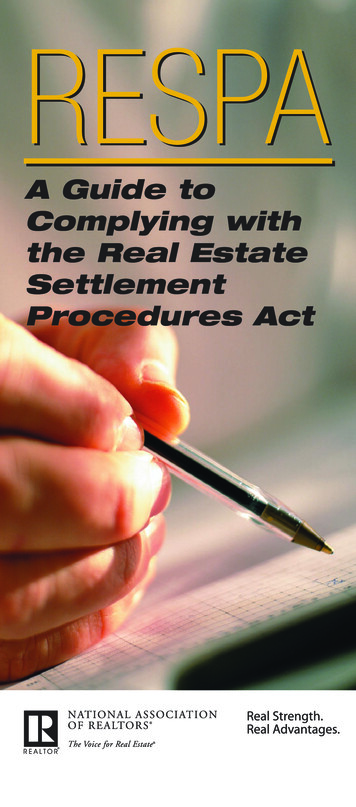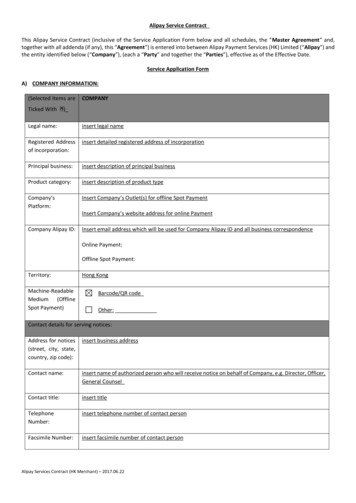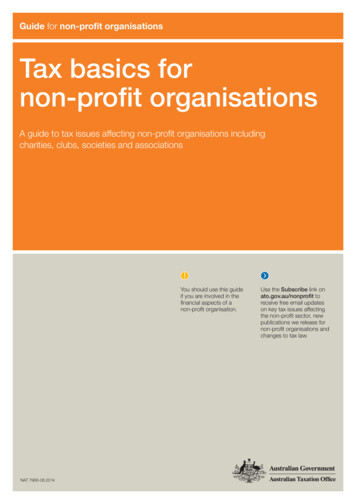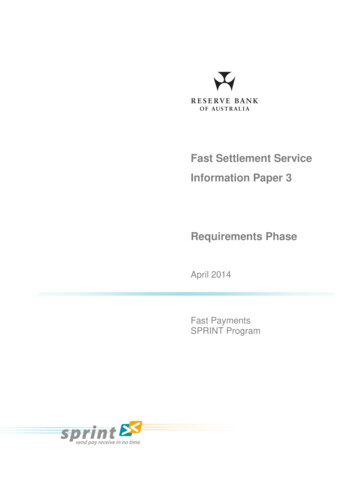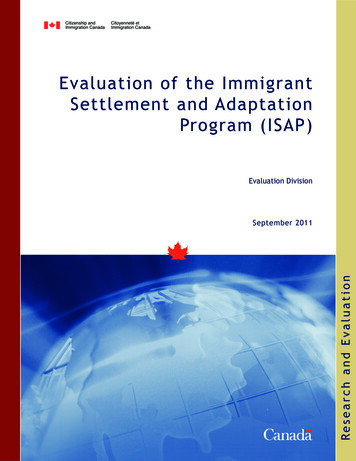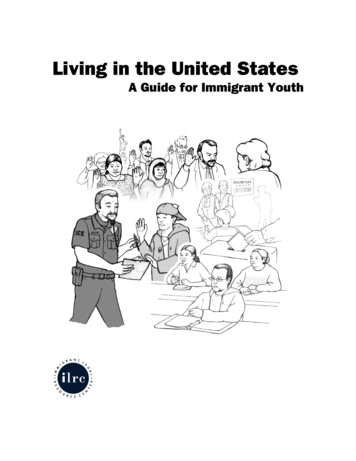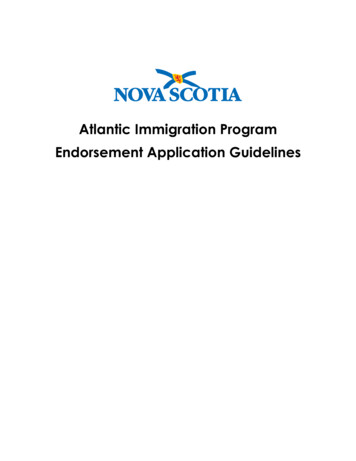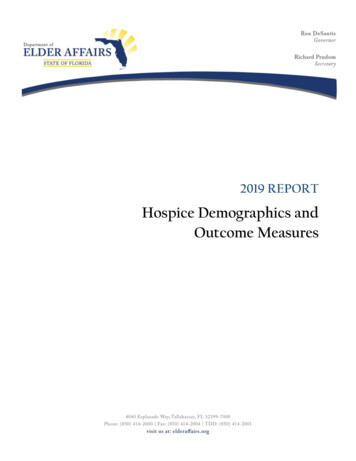
Transcription
Atlantic Metropolis Centre Working Paper SeriesCentre Métropolis Atlantique Série de documents de rechercheNon-profit Immigrant Settlement Agencies in New Brunswick:Answering the Call for Population Growth?BYLuc Thériault, PhDMichael Haan, PhDDepartment of SociologyUniversity of New BrunswickMarch 31, 2012The Atlantic Metropolis Centre’s Working Papers SeriesSérie de documents de recherche du Centre Métropolis AtlantiqueWorking Paper No.44 2012Série de documents de recherche 44-2012
The Atlantic Metropolis Centre’s Working Papers SeriesSérie de documents de recherche du Centre Métropolis AtlantiqueThe views expressed in this paper are those of the author(s) and do not necessarily reflect the view ofthe Atlantic Metropolis Centre or its funders.Les opinions contenues dans cet article sont celles des auteur(s) et ne sont pas nécessairementpartagées par le Centre Métropolis Atlantique ou ses partenaires.Copyright of this paper is retained by the author(s) Copyright de cet article est maintenu parl'auteur(s)AMC Working Papers Series / Série de documents de recherche du CMAAttention: Shiva NourpanahThe Atrium, Suite 213, Saint Mary’s University 923 Robie St., Halifax, NS, Canada B3H 3C3E-mail / courriel: atlantic.metropolis@smu.caWebsite / site Web: http://community.smu.ca/atlantic /2
We are pleased to acknowledge the AMC’spartner organizations:Federal Government Partners:Atlantic Canada Opportunities Agency, CanadaBorder Services Agency, Canada EconomicDevelopment for the Regions of Quebec, CanadaMortgage and Housing Corporation, CanadianHeritage, Citizenship and Immigration Canada,FedNor, Human Resources and SocialDevelopment Canada, Department of JusticeCanada, Public Health Agency of Canada, PublicSafety Canada, Royal Canadian Mounted Police,The Rural Secretariat, Social Sciences andHumanities Research Council, Statistics CanadaThree Lead Universities:Saint Mary's University, Dalhousie University, andUniversité de Moncton.Community Partners:Immigrant Settlement and Integration Services(ISIS), Multicultural Association of Nova Scotia(MANS), New Brunswick Multicultural Council,PEI Association for Newcomers, MulticulturalAssociation for the Greater Moncton Area,Association for New Canadians (ANC) ofNewfoundland, Canadian Council for Refugees(CCR), YMCA Newcomer Service.Le CMA tient à remercier chaleureusement lespartenaires suivants pour leur soutien:Partenaires fédéraux:Agence de promotion économique du Canadaatlantique, Agence des services frontaliers duCanada, Développement économique duCanada pour les régions du Québec, Sociétécanadienne d'hypothèques et de logement,Patrimoine Canada, Citoyenneté et ImmigrationCanada, FedNor, Ressources humaines etDéveloppement social Canada, Ministère de laJustice Canada, Agence de la santé publique duCanada, Sécurité Publique Canada,Gendarmerie royale du Canada, Le Secrétariatrural, Conseil de recherches en scienceshumaines, Statistique CanadaLes trois universités à la direction:Saint Mary's University, Dalhousie University etl'Université de Moncton.Nos partenaires communautaires:L'Association multiculturelle de Nouvelle-Écosse,Le Conseil multiculturel du Nouveau-Brunswick,L'Association multiculturelle du Grand Moncton,Association métropolitaine pour l'établissement desimmigrants, PEI Association for Newcomers,L'association des nouveaux canadiens de TerreNeuve, Conseil canadien pour les réfugiés, YMCANewcomer service, Immigrant Settlement andIntegration Services (ISIS),
TABLE OF hods9Services Offered12Clients Served14Resources Available15Governance18Accountability, Transparency and Retention23Gender-related Issues29Main Challenges34The Importance of the Local Context45Strengths47Policy PPENDICES60NOTES642
ACKNOWLEDGEMENTSThe authors would like to thank the Atlantic Metropolis Centre for funding this research andcontributing to the dissemination of its results. We are also extremely grateful to the 18organizations that opened their doors to us and to the 21 individuals who participated in ourformal interview process. A special thanks goes to the Population Growth Division (NewBrunswick Department of Post-Secondary Education, Training and Labour) for providing us withinformation and encouragement throughout the project. Dr. Thériault also wishes toacknowledge the support of the Department of Sociology at the University of New Brunswickand, in particular, the opportunity to take a sabbatical leave during the course of this research.Dr. Haan wishes to thank the Departments of Sociology and Economics at the University of NewBrunswick and the Canada Research Chairs program for supporting the research contained inthis paper. Also acknowledged is the work of Skyline Transcription Services for its help intranscribing some of the interviews conducted in English. Our research assistant, AnitaPunamiya, was charged with conducting four interviews in English for this project in and aroundthe Saint John area. She also provided a number of useful comments and suggestions on draftversions of this report. Naturally, the authors remain responsible for any errors still present inthis working paper.3
ABSTRACTThis research report presents the results of a fact-finding tour of non-profit immigrantsettlement agencies in New Brunswick. At a time when this Maritime province needsimmigration to prevent population decline, these agencies are partnering with governments tooffer services of key importance for the settlement of newcomers, including those in non-urbancommunities. As much of the research on settlement services in Canada has focussed on thelarger metropolitan centres, this study contributes to filling an existing research gap.Based on semi-structured interviews with 21 key informants working in 18 organizations, wefirst draw a portrait of the services offered by the agencies and the clients they serve. We thendescribe the resources available to the settlement agencies and the mechanisms they use forgovernance and performance of their functions in an accountable and transparent manner.After paying particular attention to some gender-related issues, we summarize the mainchallenges as self-reported by the agencies. We also stress that settlement issues tend to bevery locally driven and that the non-profit settlement agencies can count on a number ofcompetitive advantages to fulfill their mission. The report briefly discusses some key policyissues before concluding with a focus on the tension observed in the relationship betweengovernments and the non-profit sector in the delivery of settlement services. Relevant policyrecommendations are listed at the end of the document.4
INTRODUCTIONProvincial governments in the Maritimes have been concerned by the small (or non-existent)population growth in the region since around 2006 (Marquis, 2008). New immigrants currentlyaccount for the bulk of population growth in these provinces where the birth rates are low andthe population is aging. Thus, Atlantic Canada needs immigration to cope with labour shortagesand maintain economic growth. As a country, Canada has a high per capita immigration ratebut one concentrated in large metropolitan areas (e.g., Montreal, Toronto, Calgary andVancouver) outside the region. Provinces such as New Brunswick and Prince Edward Islandtherefore want to collaborate with federal authorities to increase immigration in theirjurisdiction. To recruit immigrants and encourage them to settle outside of Montreal, Torontoand Vancouver (a.k.a. the “big three”) is a potential win-win solution in that it could slow downthe well-documented decline in socioeconomic well-being and strengthen the economic, socialand demographic situations in regions where it is needed most (Beshiri and He, 2009; Bruceand Lister, 2003; Haan, 2008; Reimer, 2007).Since the establishment of the Provincial Nominee Program (PNP) in Manitoba in 1998,Canadian provinces have been able to play a greater role in selecting immigrants. This initiative(and others) from Citizenship and Immigration Canada (CIC) has been fairly successful atrecruiting immigrants to Atlantic Canada, but for these programs to truly succeed over the longterm, it is necessary to keep immigrants in the provinces where they originally land rather thanwatch them head for a gateway city. To this end, New Brunswick established in 2007 aPopulation Growth Secretariat that funds non-profit agencies to deliver settlement services tonewcomers. These community agencies can help immigrants access language training, findemployment, and connect with their new community. Many of these associations also organizesociocultural events that bring together Canadians and newcomers for cultural exchanges andthe development of a better mutual understanding. Settlement agencies are directing much oftheir work to ensure that newcomers can integrate into life in Canada. However, through public5
education and the promotion of multiculturalism, these agencies also work to ensure that localcommunities are ready to accept newcomers. The non-profit immigrant settlement agencies ofNew Brunswick are the main population explored in this study.This partnership represents a form of active collaboration between the state and the voluntarysector. The effort and resources invested by governments to develop and support settlementactivities are not insignificant, particularly in the present difficult fiscal context. For instance,the current level of annual combined federal and provincial spending on immigrant settlementservices in New Brunswick is estimated at between 7 and 8 million (Government official,personal communication, December 13, 2011).Relevance of the StudyRoughly three-quarters of recent immigrants live in Montreal, Toronto, and Vancouver (Hou2007), so the overwhelming majority of immigration research in Canada, either explicitly (byselecting only major census metropolitan areas) or implicitly (by conducting a national analysiseven though immigrants aren’t evenly distributed across the country), focuses on its “big three”census metropolitan areas (CMAs). The same is true of Canadian studies on settlement services,which have also focused on large urban centres (McGrath et al., 2010; Richmond and Shields,2005; Sadiq, 2004). In this context, an examination of what is happening in this field in smallerjurisdictions is long overdue. A smaller province like New Brunswick, which received only 2,125immigrants in 2010 (CIC, 2011), presents challenges for settlement that might not be presentelsewhere, including attitudinal issues. As will be shown in this report, some local communitiesin New Brunswick still need to work toward becoming more welcoming (see also Hanson andBarber, 2011: 19).Research on the efficacy of settlement services has implications not only for immigrantsthemselves but also for the communities of which they are a part. 2008 was the first year inwhich more humans worldwide lived in urban areas than in rural regions; in response, theGovernment of Canada has expressed its concern about the ‘over-urbanization’ of itspopulation. Canada, along with 85% of other United Nations member states, acknowledges that6
it must become more proactive in directing population settlement (UNFPA 2008). Enhancingthe potential of settlement services is a critical component of this mandate.Objectives of the StudyThe purposes of this study are to describe the work performed by settlement agencies, reviewthe resources at their disposal, identify the challenges they face, and discuss their practices inrelation to the existing policy context in New Brunswick, with some insights also gleaned fromPEI’s experience. More specifically, based on semi-structured interviews conducted with agencyleaders and government officials, and using a qualitative research design, this research aims to describe the resources and strengths available to these settlement agencies inaccomplishing their mission; explore the barriers and challenges encountered in delivering services to immigrants withinthe existing policy context; identify and discuss some of the practices employed by these agencies to use theirresources most effectively; provide information to stakeholders (agencies, governments, immigrants, employers,academics and the general public) on the opportunities and limitations of using non-profitagencies to offer settlement services to newcomers; and recommend areas for improvement in offering settlement services.Conceptual FrameworkMany contemporary Canadian discussions about and analyses of public policies are framed in apublic sector versus private sector bipolar discourse debating the relative merits of stateintervention and market mechanisms. This perspective overlooks other important social actors,7
however, such as families and friends (the informal sector) and the voluntary and non-profitsector situated between state and market (Phillips et al., 2001). However, welfare pluralism is aperspective that takes into account these other social actors or sectors in the delivery of humanservices (Skelton, 1998). It is an effective approach for analyzing a human service area, whetherhomecare, childcare or immigrant settlement services. It suggests beginning the investigationby asking key informants relatively basic questions, such as “what services are offered?”, “towhom are these services offered?”, “how are these services funded?”, “how are the servicesdelivered?”, and “how are the services regulated or monitored?” The real potential of thisperspective can be seen when the answers to these questions are combined into differentpossible permutations to illuminate the true picture of what is happening with these types ofservices (Thériault, 2012).8
MethodsThis research is based primarily on information reported to us by key informants who sharedhow they experience and perceive immigration issues. In this context, we conducted semistructured interviews with 21 informants representing 18 different organizations (see Table 1).This method ensures that the focus remained on the informant and his or her experience andexpertise (McCraken, 1988). Sixteen (16) such interviews were conducted face to face onlocation and two were administered by phone. The bulk of the information was provided byrepresentatives of non-profit settlement agencies, but two interviews were also conductedwith government officials, along with one pre-test interview with a respondent from anethnocultural association. That particular interview confirmed to us that our focus on serviceswould be best served by limiting our data collection to settlement agencies rather than alsoincluding ethnocultural organizations.Five (5) interviews were conducted in French and 16 in English, each lasting typically between30 and 90 minutes. Eleven (11) respondents were women and ten (10) were men, and all theinterviews were conducted between August and September 2011. Transcription (and in somecases translation) of the interviews was completed at the end of October, and data analysisbegan in earnest in November 2011.Table 1: Selected Characteristics of Interviewed OrganizationsType of Organization# of Interviews # of IntervieweesProvinceSettlement Agencies and1417NB & PEIUmbrella Organizations11NBGovernment Agencies11NB11PEIOther (Ethnocultural Assoc.)11NBTOTAL182129
The interview schedule used in this study was developed based on a previous study of humanservice organizations in New Brunswick (Thériault et al., 2008). It covered the followingthemes: 1) services offered, 2) clients served, 3) assets and resources of the organizationproviding the services, 4) governance, 5) accountability, 6) local context, 7) gender issues, 8)main challenges, 9) best practices or strengths, 10) policy, and 11) other issues.Funding for this research was received from the Atlantic Metropolis Centre in June 2011. Theproject was approved by the Research Ethics Board in May and is on file at the University ofNew Brunswick (Fredericton) as REB File # 2011-056. All participants were informed verballyand in writing about the nature and purpose of the project and given the option to refuse toanswer any question or opt out of the project entirely (see Consent Form in appendix).In giving written consent for their participation in this study, informants could choose the levelof confidentiality they were comfortable with our using in reporting their information (seeconsent form in Appendix). To our surprise, in only two organizations did the intervieweesrequest the “high” level of confidentiality. Respondents from ten organizations selected the“medium” level, while those from the remaining six (four of which were francophone) chose towaive their right to confidentiality and allow us to associate their comments with their nameand organization as we saw fit in this analysis.Identifying the settlement agencies and umbrella organizations to be approached to participatein the study was relatively easy, as this is public information, and the number of agencies inNew Brunswick and PEI is small. We nevertheless crosschecked our list for completeness withour contacts at the New Brunswick Population Growth Division (PGD) of the Department ofPost-Secondary Education, Training and Labour (PETL).We enjoyed excellent participation in the study as we were able to secure an interview with allbut one organization contacted. In fact, most participants were extremely accommodating andeager to share their experience with us, and they also showed a genuine interest in thisresearch. We would argue, therefore, that the information in this report can be consideredrepresentative of nearly all settlement agencies in New Brunswick. The agencies visited are10
located all over New Brunswick, including in its three main urban centres (Fredericton,Moncton and Saint John), some smaller municipalities, and small towns serving semi-ruralareas, with a concentration of francophone agencies in the northern half of the province. Someagencies, such as MAGMA in Moncton and MACR in Bathurst, offer bilingual services, while inPEI, services are centralized in a single agency, where we conducted an interview (# 08) onSeptember 9, 2011.It should be noted that this study centres on the situation in our home province of NewBrunswick and is not, strictly speaking, a comparison between the policy and practices in NewBrunswick and those in PEI. However, the PEI example does offer in some instances aninteresting comparison for our analysis and discussion. We analysed the qualitative datacollected in this research using themes pre-established at the time the interview schedule wasconstructed. As is the case in this type of semi-grounded approach, other themes for analysis(transportation, for instance) emerged during data collection (Corbin and Strauss, 1990), butthe overall validity of this study rests ultimately on the richness and the sheer amount of datacollected as shown by Becker (1970) in his seminal work on methodology.11
Services Offered by Settlement AgenciesThe non-profit settlement agencies that took part in this study provide a range of services, withmost offering many of the common ones. Other services are offered by only a small number ofagencies and have unique nuances geared to their specific client groups and locations. Tounderstand the services offered, it is also important to remember that different organizationswere created at different times so are at different stages of maturity in terms of organizationaldevelopment. Therefore, the capacity to provide services differs from one organization to theother.Among the most common services is first some form of language training tailored to the needsof adult immigrants. In some agencies, this is a formal, well-established program (such as ESL),while in others, it may be more informal. Depending on the community, the language trainingtends to be offered only in English (for example, in Florenceville and St. George) or only inFrench (for example, in Caraquet and Saint-Léonard). In the larger centres, such as Saint Johnand Moncton, language training is available in both English and French (but not necessarily inthe same agency).The second common type of services relates to employability. Here, services help with resumewriting, job search and interview skills, and occasionally some job placement or internshipprograms, as well as entrepreneurship information. Less common are the programs or activitiesgeared specifically to potential employers, although a number of agencies are trying to cultivateactive contacts with local businesses in a variety of ways.The third type of commonly found services includes standard settlement services, such asproviding airport pick-ups, finding appropriate housing and furniture, providing help obtainingdocuments like driver’s licences and Medicare cards, filling out bureaucratic forms, andregistering children in school. On the community education side, several agencies makepresentations in schools and other venues to educate and sensitize the community onimmigration issues.12
Most agencies also organize social events, such as a short outing to a local park or to a foreignfilm, where immigrants can both meet other newcomers and also be introduced to friendlyCanadians. A few larger agencies have a wider offering of services, including life skills activities(such as cooking classes), and also host various information sessions offered by other partneragencies (such as the RCMP). Finally, a couple of agencies have started to offer services toseniors and youth, two age groups not usually well served by settlement services.Obviously, what can be offered is what can be funded; funding, not the imagination of theagencies, is the limiting factor. Therefore, funders (mainly governments) have a considerableinfluence in defining the mandate of the agencies and what services they can offer.Most agencies use a traditional social services delivery model: they try to serve the people whowalk through their doors the best they can. This is a fairly reactive approach, mainly centred onthe newcomers and might not be enough to optimize immigrant retention numbers. Moreefforts may be needed to engage employers and to persuade them to hire immigrants. Further,more relationships need to be built with local employers to give them the tips and tools (evenperhaps government incentives) to hire, manage and retain newcomers. Without successfulemployment, all other settlement activities may contribute relatively little to the ultimate goalof retaining immigrants in the province.While some useful tools and templates are made available to settlement agencies by the NewBrunswick Multicultural Council (NBMC), the provinces’s umbrella organization for the sector,and some information sessions are offered at the NBMC’s annual conference, we were toldlittle about harmonized trainings that would be available to, and used by, these agencies acrossthe province. The impression we were left with after our tour of the province was that mostagencies are still learning by trial and error, with a few longer established ones having set firmguidelines for service delivery, partly because receiving immigrants from very diverse cultures isstill a fairly new reality in the history of the province.13
Clients ServedThe immigrant settlement agencies we visited serve many categories of clients. Permanentresidents constitute the largest group in most agencies, the major reason being that the federalfunding by Citizenship and Immigration Canada is earmarked for permanent residents only.Other categories of clients include temporary foreign workers, who represent a large part ofthe clientele in a limited number of small agencies. They, like international students, receiveservices funded by the province.It is important to stress that the immigrant client composition differs from one town toanother. In some locations we find very few temporary foreign workers, while in other placesthey make up a significant part of the clientele. Even the typical profile of the foreigntemporary worker differs from one agency to another. In Woodstock, he/she might be a truckdriver, while in the Bathurst area, the worker might be a mining engineer or a skilled healthcareworker.As for refugees, they are essentially served by larger agencies in the three larger urban centres,with the notable exception of Saint-Léonard, where CIRNO has developed a speciality servingthem in a semi-rural milieu. Immigrant settlement agencies also offer services to a limitednumber of immigrant entrepreneurs sponsored by the province. Some people visiting Canadaand doing an exploratory trip before immigrating are also among the clients servedoccasionally, while others may be in the country under a work permit and require someinformation. Even Canadians moving in from other provinces receive some services fromcertain agencies.As with many other human services, or with casework in social work, the services generally arenot limited to the primary client but extend to his or her entire family. Spouses, children andoccasionally grandparents are also being served, even if they might be counted as part of onecase. Services are also received for various lengths of time, from a punctual once-only contact(to deal with a specific form) to a maximum of three years of service contact – the period14
needed to obtain Canadian citizenship. But in most cases, clients receive services for one or twoyears.Resources AvailableThe federal and provincial governments are the main (and in some cases the only) funders ofthe province’s settlement agencies. At the federal level, this funding is provided primarily byCitizenship and Immigration Canada (CIC), although other departments, such as Status ofWomen Canada or Human Resources and Skills Development Canada, may fund certainactivities in a few agencies. At the provincial level, funding comes mainly through theDepartment of Post-Secondary Education, Training and Labour (PETL), particularly through itsPopulation Growth Division (PGD), formerly known as the Population Growth Secretariat. In2010-11, the PGD’s total budget was about 4.87 million (GNB, 2011: 135). Some of its agencyfunding is actually money provided by the Atlantic Canada Opportunities Agency (ACOA) for alimited time. Again, some other provincial departments (the Department of Wellness, Cultureand Sport, for instance) may also provide some funding for specific projects or activities.In terms of size, most settlement organizations fit into a three-fold typology based on bothannual budget and the number of full-time employees. Most in this typology would beconsidered small or medium sized, with only a few large organizations. Typically, “small”organizations are those with an annual budget of less than 300,000 and about three full-timeemployees: the coordinator or director, who is also a service provider, an employee workingfull time on settlement services, and an administrative secretary receptionist. Medium-sizedagencies are those with annual budgets roughly between 300,000 and 500,000 with four tosix full-time employees and often one part-time employee. Large agencies are limited to eitherumbrella or province-wide organizations like NBMC and PEI ANC or some agencies in the mainurban centres. Large agencies typically have a budget over 1,000,000 and between about 7and 30 full-time employees.1Overall, the budgets of most settlement agencies in New Brunswick (characterized above assmall or medium sized) are relatively modest given the financial requirements of running a15
modern human services organization. With few exceptions, the settlement agencies studiedhave annual budgets below 500,000. In fact, Thériault et al. (2008: 218) found that 75% ofcharitable human service organizations in New Brunswick have budgets below 500,000, andonly 20% have budgets in excess of 1 million. Non-profit immigrant settlement agenciestherefore seem to conform to the size pattern found elsewhere in the province’s non-profitsector. Employee compensation levels also can be characterized as modest and in line with theusually low levels of compensation found in Canada’s voluntary sector (Thériault, 2004).From a public administration perspective, another advantage associated with the non-profitdelivery of human services (aside from the lower costs of employee compensation) is thecapacity of non-profit agencies to recruit the help of unpaid volunteers in the local communityand benefit from various forms of in-kind support. The agency leaders we spoke to mention theinvaluable help volunteers provide their organization. The volunteer base at their disposalseemed to range from 15 to 150 individuals depending on the location, size and the age of theorganization. While difficult to measure precisely, this volunteer component certainlyrepresents an important (but often overlooked) contribution to the settlement of newcomers inthe province.Finally, various community partners also provide in-kind support to the work of the settlementagencies that can, in some cases, be quantified in monetary values and also be quite significant.For instance, some municipalities, as well as local New Brunswick Community Colleges (NBCC),have been cited as major in-kind supporters by providing free office space for some settlementagencies. In the case of CAIENA, in the Acadian peninsula, three local partners play that role, asthe interviewee explains:The community contributes a lot also to our work. We have 3 points of services (here, theUniversité de Moncton - Shippagan Campus and Enterprise Peninsula) and we don’t payrent. It is picked up by the New Brunswick Department of Fisheries here, the UMCS at theUniversity and by Enterprise Peninsula at their location. So we save rent and thisrepresents about 30,000 per year! It is an important contribution from the community.[Interview #06]16 pa
Luc Thériault, PhD Michael Haan, PhD Department of Sociology University of New Brunswick March 31, 2012 The Atlantic Metropolis Centre's Working Papers Series Série de documents de recherche du Centre Métropolis Atlantique Working Paper No.44 2012 Série de documents de recherche 44-2012
